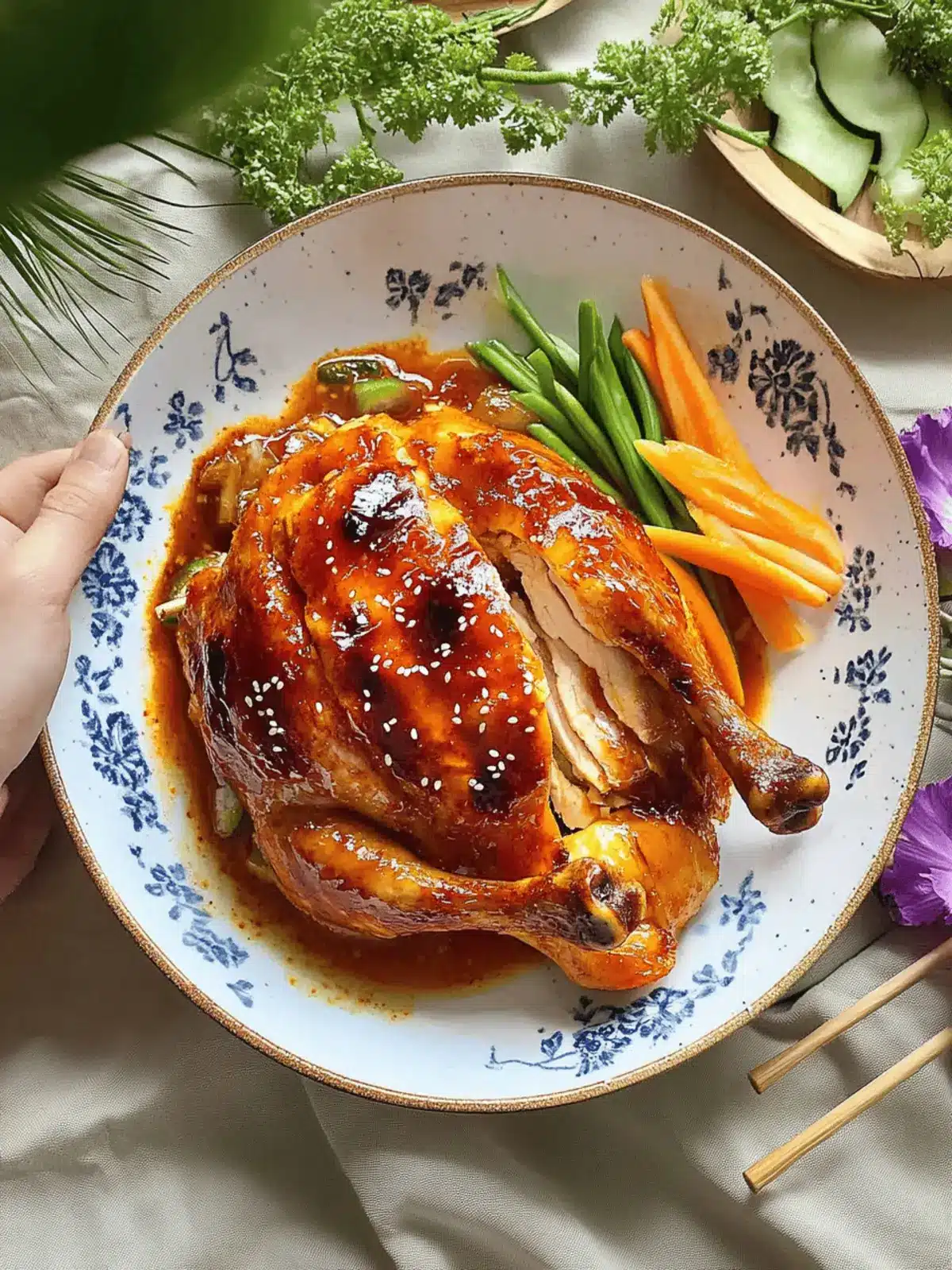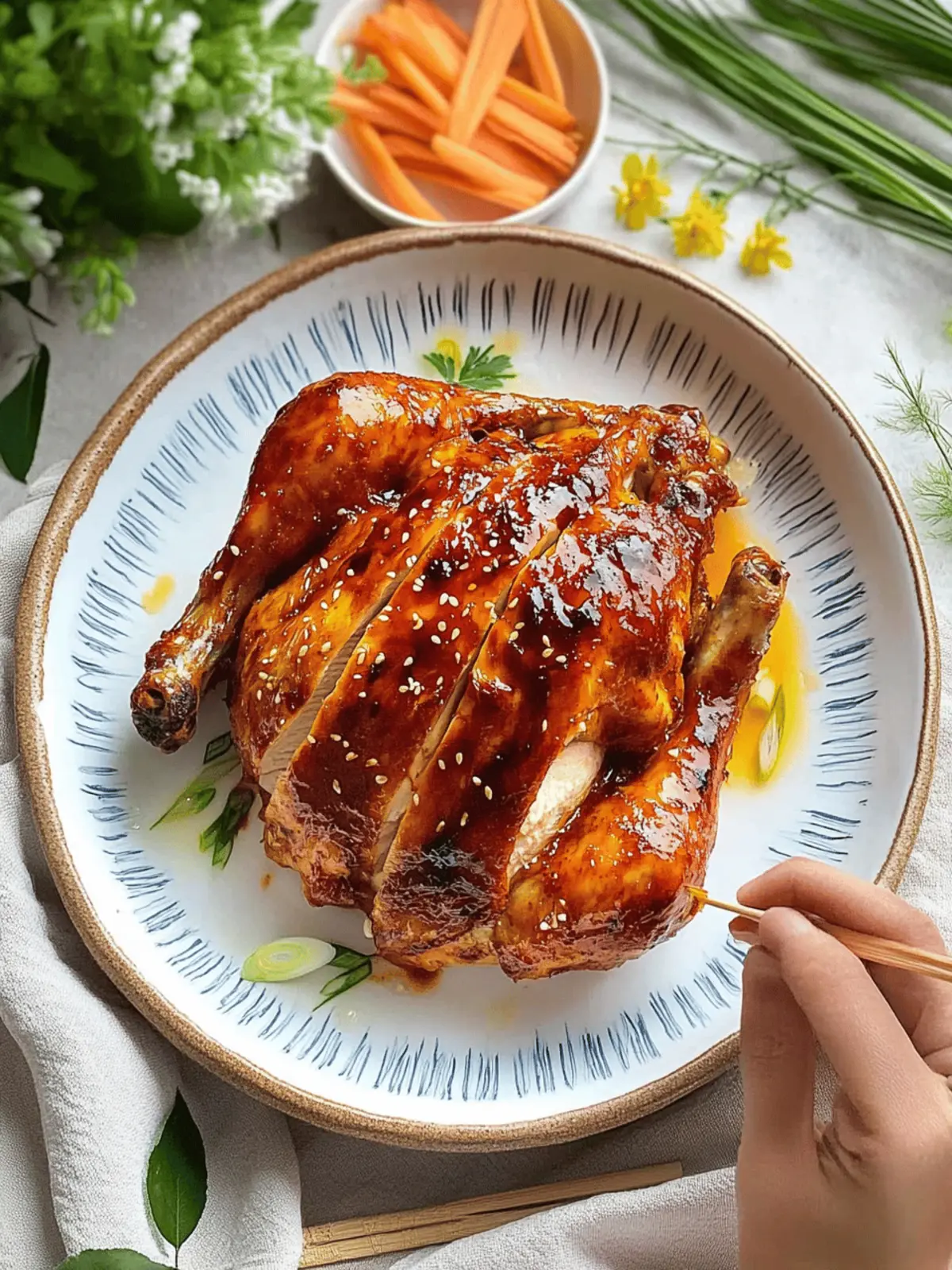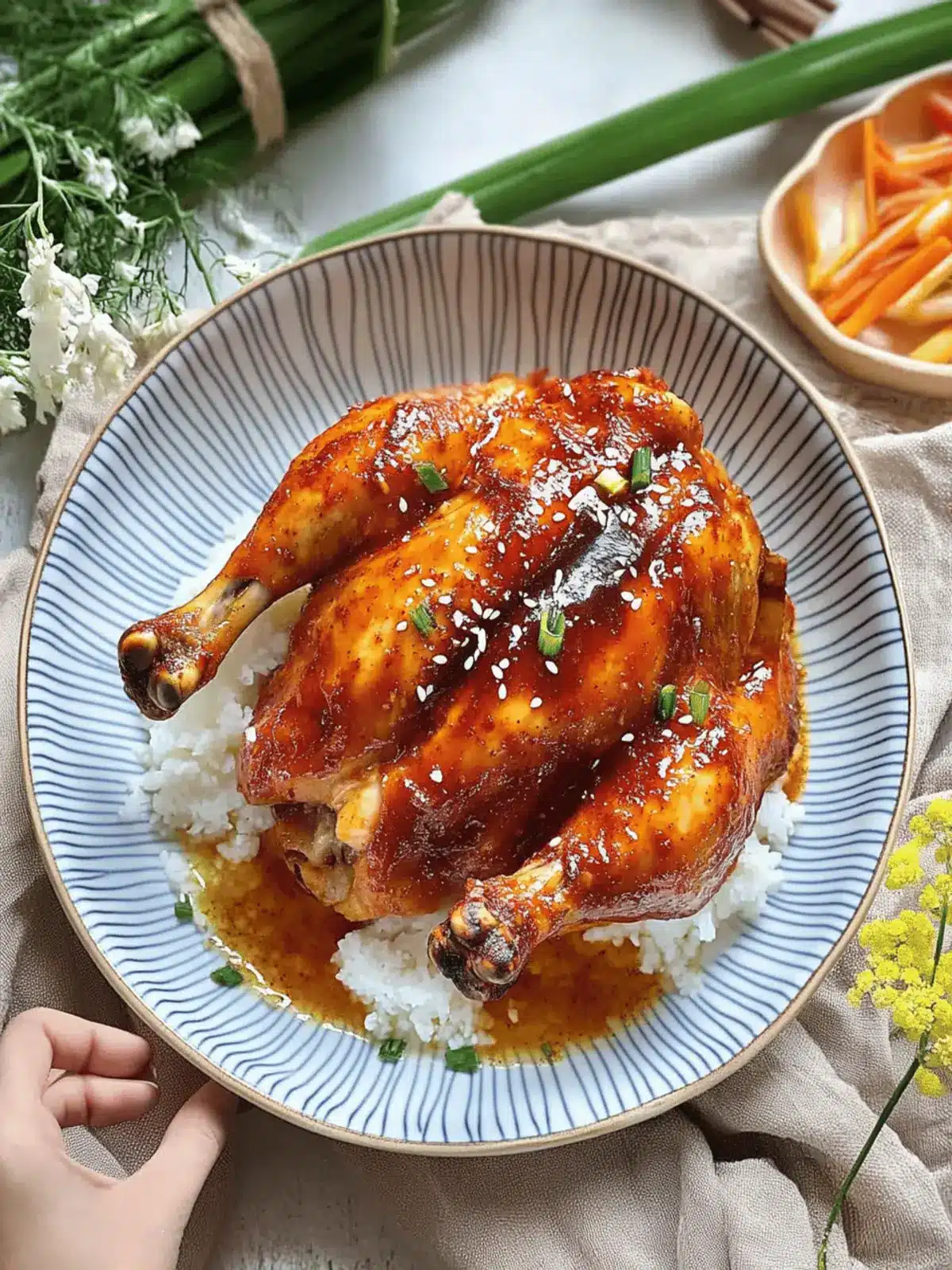After a long day filled with the hustle and bustle of life, there’s nothing quite as satisfying as coming home to the fragrant aroma of roasted chicken wafting through the air. This Easy Korean Gochujang Chicken is that perfect solution—a delicious blend of sweet, spicy, and savory flavors that brings warmth to any dinner table. I first discovered this incredible dish while experimenting with some pantry staples, and it quickly became a family favorite.
When life gets hectic, this recipe makes an enticing weeknight dinner simple, showcasing the vibrant essence of Korean cuisine in no time. The marinade, bursting with gochujang, soy sauce, and aromatic ingredients, envelops the chicken in a flavor-packed embrace while keeping the meat juicy and tender. Whether you’re planning an intimate date night or a cozy family gathering, this dish not only impresses but also satisfies the craving for comfort food with a spicy kick. Trust me, once you try this mouthwatering recipe, you won’t want to go back to takeout!
Why is Korean Gochujang Chicken a Must-Try?
Flavor Explosion: The marinade features a delightful mix of gochujang, soy sauce, and aromatic garlic, bringing deep, spicy notes that dance on your palate.
Easy to Prepare: Every step is simple, making it perfect for busy weeknights—just marinate and roast!
Crowd-Pleaser: This dish is sure to impress family and friends, becoming the star of your dinner table.
Versatile Options: Pair it with rice, kimchi, or lettuce wraps for a complete meal. Plus, you can easily adjust the spice level to cater to your taste.
Comforting Dish: The crispy skin and juicy meat create a heartwarming experience that’s best shared with loved ones.
Korean Gochujang Chicken Ingredients
For the Chicken
• Whole Chicken (2-3 pounds) – Main protein; can substitute with chicken parts, but adjust cooking times as needed.
For the Marinade
• Korean Gochujang Paste (¼ cup, or 4 tablespoons) – Provides depth of flavor with a sweet, spicy kick for your Korean Gochujang Chicken.
• Neutral Vegetable Oil (2 tablespoons) – Essential fat for cooking; sunflower oil is preferred, though olive oil works too.
• Oyster Sauce (2 tablespoons) – Adds rich umami flavors that complement the chicken beautifully.
• Light Soy Sauce (1.5 tablespoons) – Enhances saltiness and can be swapped with fish sauce if desired.
• White Granulated Sugar (1.5 tablespoons) – Balances the heat from the gochujang; honey serves as a great substitute.
• White Rice Vinegar (1 tablespoon) – Brightens the flavors; avoid using lemon juice, as it can alter the taste significantly.
• Mirin (1 tablespoon) – Offers sweetness; for a different twist, swap with sake or soju while adjusting the sugar slightly.
• Sesame Oil (½ tablespoon) – Imparts a lovely nutty flavor that enriches the dish.
• Garlic (3 cloves, grated) – Provides aromatic intensity, enhancing the overall flavor profile.
• Ginger (1.5 inches, grated) – Adds warmth and zing; ginger powder can be used in a pinch but offers less punch.
For the Garnish
• Sliced Spring Onions – Adds freshness and color, enhancing presentation.
• Toasted White Sesame Seeds – Sprinkled on top for an extra touch of texture and flavor.
How to Make Korean Gochujang Chicken
-
Marinate Chicken: In a large bowl, whisk together all marinade ingredients. Thoroughly coat the chicken, making sure to get the marinade into every nook and cranny. Let it marinate in the refrigerator for 8-16 hours; this will infuse amazing flavor!
-
Preheat Oven: After marinating, take the chicken out and let it reach room temperature for about 30 minutes. Preheat your oven to 356°F (180°C), ensuring it’s ready to cook your delicious bird.
-
Roast Chicken: Place the chicken in a roasting pan and bake uncovered for 30 minutes. Then, cover it with aluminum foil and continue to roast for another hour, or until the juices run clear when pierced with a knife.
-
Resting Period: Once done, allow the chicken to rest for 15-20 minutes before carving. This step helps keep the meat juicy and tender, making every bite delightful.
-
Optional Crisping: For an extra crispy skin, broil the chicken for 1-2 minutes after applying a tablespoon of the boiled marinade, watching closely to prevent burning.
Optional: Serve with a sprinkle of toasted sesame seeds for added flavor and crunch.
Exact quantities are listed in the recipe card below.
Expert Tips for Korean Gochujang Chicken
• Marinade Thoroughly: Ensure to rub the marinade deep inside the chicken cavity for maximum flavor penetration, enhancing your Korean Gochujang Chicken.
• Mind the Marinade: Avoid pouring excess marinade liquid into the roasting pan to prevent sogginess; reserve it as a glaze after boiling for safety.
• Placement Matters: Don’t steam the chicken by positioning vegetables too close. Ensure they sit below the chicken to allow for crispy skin.
• Temperature Check: Use a meat thermometer to confirm the chicken reaches an internal temperature of 165°F (75°C) for safe consumption.
• Resting is Key: Allow the chicken to rest post-roasting; this step locks in juices, ensuring succulent meat and a perfect dining experience.
Storage Tips for Korean Gochujang Chicken
Fridge: Store any leftovers in an airtight container in the refrigerator for up to 3 days to maintain flavor and freshness.
Freezer: If you want to keep your Korean Gochujang Chicken for longer, freeze it in an airtight container or heavy-duty freezer bag for up to 3 months.
Reheating: When ready to enjoy leftovers, reheat in the oven at 350°F (175°C) for about 20-25 minutes, or until heated through. Alternatively, use a microwave on low power, covering with a damp paper towel to prevent drying out.
Use the Bones: Don’t forget to save the bones after carving! You can use them to make a rich chicken stock, enhancing your next culinary adventure.
Make Ahead Options
These Easy Korean Gochujang Chicken recipes are perfect for meal prep, saving you valuable time during busy weeknights! You can marinate the chicken up to 24 hours in advance; simply coat it with the delicious marinade and refrigerate it until you’re ready to cook. Additionally, you can roast the chicken in advance and store the leftovers in an airtight container for 2-3 days—just reheat in the oven to preserve the skin’s crispiness. When you’re ready to enjoy this flavorful dish, remember to let it rest for 15-20 minutes after roasting for juicy results. Trust me, the meals you prep ahead will be just as delicious!
Korean Gochujang Chicken Variations
Feel free to make this recipe your own with delightful twists and substitutions!
- Chicken Parts: Swap the whole chicken for thighs, drumsticks, or wings for quicker cooking and easier serving.
- Vegetarian Option: Replace chicken with tofu or tempeh, marinating as instructed, and baking until golden for a delightful vegetarian version.
- Extra Spice: Kick up the heat by adding more gochujang, or toss in a spoonful of gochugaru for a smoky kick that’s not overpowering.
- Sweet N’ Sour: Balance the spice by incorporating a splash of pineapple juice into the marinade for a sweet tang that complements the savory notes.
- Herb Infusion: Add fresh herbs like cilantro, basil, or scallions to the marinade for an aromatic twist that elevates the flavor profile beautifully.
- Coconut Touch: Substitute half the vegetable oil with coconut milk for a creamy, slightly sweet texture that enhances the overall richness.
- Nutty Flavor: Replace sesame oil with peanut or almond oil for a different nutty depth that will surprise your taste buds.
- Fermented Kick: For added umami, mix in a tablespoon of miso paste to the marinade, enhancing the dish with complex flavors that are simply irresistible.
What to Serve with Korean Gochujang Chicken?
Creating a full meal around this spicy delight is an opportunity to explore vibrant, comforting pairings.
-
Steamed Jasmine Rice: Light and fluffy, jasmine rice soaks up the flavorful sauce, making each bite a delicious experience.
-
Savory Kimchi: The tangy, spicy profile of kimchi contrasts beautifully with the sweetness of the chicken, adding a refreshing crunch.
-
Crispy Cucumber Salad: A simple salad with cucumbers tossed in rice vinegar offers a cool and crunchy texture to balance the meal’s heat.
-
Roasted Vegetables: A medley of seasonal vegetables, like broccoli and bell peppers, adds both color and nutrition, enhancing the overall presentation.
-
Spicy Korean Noodles: Pair the chicken with chewy noodles tossed in spicy sesame oil for an unforgettable meal that celebrates Korean flavors.
-
Chilled Soju or Beer: A glass of chilled Soju or a light beer complements the spicy notes, providing a refreshing contrast to the rich chicken.
-
Sesame Spinach Salad: Lightly seasoned spinach sprinkled with sesame seeds alongside the chicken brings a nutritious green element to your plate.
-
Mango Sticky Rice: For dessert, this sweet dish is a delightful way to cleanse the palate, with a perfect blend of sweetness and creaminess.
Korean Gochujang Chicken Recipe FAQs
What should I look for when selecting a whole chicken?
Absolutely! When selecting a whole chicken, ensure it has firm, plump flesh and no dark spots or off odors. The skin should be smooth and pale, indicating freshness. If you’re opting for frozen, look for packages with no signs of freezer burn.
How should I store leftover Korean Gochujang Chicken?
Store any leftovers in an airtight container in the refrigerator for up to 3 days. Make sure to let the chicken cool down to room temperature before sealing it. Keeping it wrapped tightly will help preserve its flavors and moisture.
Can I freeze Gochujang Chicken, and how?
Very! To freeze Korean Gochujang Chicken, let it cool completely, then place it in an airtight container or a heavy-duty freezer bag. Press out any excess air and seal tightly. It can be frozen for up to 3 months. When you’re ready to enjoy it, thaw in the refrigerator overnight and reheat in the oven for the best texture.
What if my chicken isn’t cooking evenly?
If you find your chicken isn’t cooking evenly, check your oven temperature using an oven thermometer as they can sometimes be off. Ensure the chicken is positioned in the center of the oven for even heat distribution. For larger chickens, consider spatchcocking (removing the backbone) to promote more even cooking!
Is this recipe suitable for people with soy allergies?
For those with soy allergies, you can substitute the soy sauce with coconut aminos or a homemade soy-free sauce. Just keep in mind that this may alter the overall flavor profile slightly, but it will still be delicious! Always double-check labels for additional allergens when using pre-prepared ingredients.

Spicy Korean Gochujang Chicken for an Epic Dinner Night
Ingredients
Equipment
Method
- In a large bowl, whisk together all marinade ingredients. Thoroughly coat the chicken, making sure to get the marinade into every nook and cranny. Let it marinate in the refrigerator for 8-16 hours.
- After marinating, take the chicken out and let it reach room temperature for about 30 minutes. Preheat your oven to 356°F (180°C).
- Place the chicken in a roasting pan and bake uncovered for 30 minutes. Then, cover with aluminum foil and continue to roast for another hour, or until the juices run clear when pierced with a knife.
- Once done, allow the chicken to rest for 15-20 minutes before carving.
- For an extra crispy skin, broil the chicken for 1-2 minutes after applying a tablespoon of the boiled marinade, watching closely to prevent burning.








